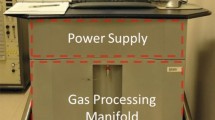Abstract
Pacific Northwest National Laboratory, with guidance and support from the U.S. Department of Energy's NN-20 Comprehensive Test Ban Treaty (CTBT) Research and Development program, has developed and demonstrated a fully automatic sampler-analyzer (ARSA) for the collection and quantitative measurement of the four xenon radionuclides,131mXe (11.9 d),133mXe (2.19 d),133Xe (5.24 d), and135Xe (9.10 h), in the atmosphere. These radionuclides are important signatures in monitoring for compliance to a CTBT, and may have applications in stack monitoring and other areas where xenon radionuclides are present. The activity ratios between certain of these radionuclides permit discrimination between radioxenon originating from nuclear detonations and that from nuclear reactor operations, nuclear fuel reprocessing, or from medical isotope production and usage. With the ARSA system, xenon is continuously and automatically separated from the atmosphere at flow rates of about 100 lpm by sorption-bed techniques. Samples collected in 8 hours are automatically analyzed by electron-photon coincidence spectrometry to provide detection sensitivities as low as 100 μBq/m3 of air. This sensitivity is about 10-fold better than achieved with reported laboratory-based procedures1 for the short time collection intervals of interest. Gamma-ray energy spectra and gas analysis data are automatically collected.
Similar content being viewed by others
References
L.-E. DeGeer, Atmospheric Radionuclide Monitoring: A Swedish Perspective, in: Monitoring a Comprehensive Test Ban Treaty,E. S. Husebye andA. M. Dainty (Eds), NATO ASI Series E: Applied Sciences, Vol. 303, Kluwer Academic Publishers, Boston, 1995, p. 157.
T. W. Bowyer, K. H. Abel, W. K. Hensley, C. W. Hubbard, M. E. Panisko, R. W. Perkins, P. L. Reeder, R. C. Thompson, R. A. Warner, Automatic Radioxenon Analyzer for CTBT Monitoring, PNNL-11424, (December, 1996), Pacific Northwest National Laboratory, Richland, WA, also see http://www.ctbt.doe.gov.
T. W. Bowyer, K. H. Abel, W. K. Hensley, M. E. Panisko, R. W. Perkins, J. Environ. Radioact., 37 (1997) No. 2, 143, also see PNNL-SA-27197, Pacific Northwest National Laboratory, Richland, Washington.
M. S. Bolmsjö, B. R. R. Persson, Med. Phys., 9 (1982).
B. Bernstrom, L.-E. DeGeer, Xenon-133 I Luft, FOA Rapport, C-20515-A1, Forsvarets Forskningsanstalt, Huvudavdelning 2, 102 54 Stockholm, Sweden, 1983.
C. O. Kunz, Atmos. Environ. 23 (1989) 1827.
C. O. Kunz, C. J. Paperiello, Science, 192 (1976) 1235.
C. O. Kunz, Separation Techniques for Reactor-Produced Noble Gases, in: Noble Gases,R. E. Stanely andA. Moghissi (Eds), Report No. EPS/600/9-76/026, NTIS Accession No. PB-259 085/9, National Technical Information Service (NTIS), Washington, DC, 1973, p. 209.
D. T. Pence, C. C. Chou, J. D. Christian, W. J. Paplawsky, Noble Gas Separation with the Use of Inorganic Adsorbents, in: Proc. 15th DOE Nuclear Air Cleaning Conference, CONF 780819, Pt. 1, 1978, p. 512.
A. D. LeBlanc, H. J. Evans, P. C. Johnson, G. Timpe, J. Nucl. Med., 20 (1979) p. 981.
P. L. Reeder, T. W. Bowyer, R. W. Perkins, Beta-Gamma Counting System for Xe Fission Products, PNNL-SA-28235, Intern. Conf. on Methods and Application of Radioanalytical Chemistry, Kailua-Kona, HI, April 6–11, 1997, to be published in J. Radioanal. Nucl. Chem.
P. L. Reeder, T. W. Bowyer, Delayed Coincidence Technique for133gXe Detection, PNNL-SA-29187, Aug. 1997, Pacific Northwest National Laboratory, Richland, WA., also in print in Nucl. Instr. Meth. Phys. Res. A.
P. L. Reeder, T. W. Bowyer, Xe Isotope Detection and Discrimination Using Beta Spectroscopy With Coincident Gamma Spectroscopy, PNNL-SA-29188, Aug. 1997, Pacific Northwest National Laboratory, Richland, WA., also in print in Nucl. Instr. Meth. Phys. Res. A.
R. C. Weast, M. J. Astle, W. H. Beyer, CRC Handbook of Chemistry and Physics, 67th ed., CRC Press, Inc., Boca Raton, FL, (1986–1987), p. E-2 and E12-16.
P. L. Reeder, T. W. Bowyer, K. H. Abel, Analysis of Beta-Gated Gamma Spectra for the PNNL ARSA and Estimate of Minimum Detectable Activities for (131mXe+133mXe),133gXe, and135gXe, PNNL-11784, Pacific Northwest National Laboratory, Richland, WA, Dec. 1997.
C. Sanderson, report in preparation.
P. L. Reeder, T. W. Bowyer, K. H. Abel, C. W. Hubbard, M. E. Panisko, R. C. Thompson, R. A. Warner Observation of135Xe with the PNNL ARSA System, PNNL-11654, Pacific Northwest National Laboratory, Richland, WA, 1997.
Author information
Authors and Affiliations
Rights and permissions
About this article
Cite this article
Bowyer, T.W., Abel, K.H., Hubbard, C.W. et al. Field testing of collection and measurement of radioxenon for the Comprehensive Test Ban Treaty. J Radioanal Nucl Chem 240, 109–122 (1999). https://doi.org/10.1007/BF02349143
Received:
Issue Date:
DOI: https://doi.org/10.1007/BF02349143




